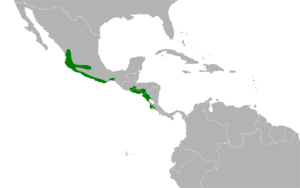Stripe-headed sparrow facts for kids
Quick facts for kids Stripe-headed sparrow |
|
|---|---|
 |
|
| Conservation status | |
| Scientific classification | |
| Genus: |
Peucaea
|
| Species: |
ruficauda
|
 |
|
| Synonyms | |
|
Aimophila ruficauda |
|
The stripe-headed sparrow (Peucaea ruficauda) is a type of American sparrow. These birds live and raise their young along the Pacific coast. You can find them from southwestern Mexico all the way down to northern Costa Rica.
Contents
Where Stripe-Headed Sparrows Live
This common bird likes to live in low-lying areas. In the northern parts of its home, it can be found up to 1,800 meters (about 5,900 feet) high. In Costa Rica, it lives up to 800 meters (about 2,600 feet) high.
Stripe-headed sparrows prefer places with lots of bushes. They like grassy areas, new plant growth, and the edges of forests. However, they do not go deep into the forest.
What Stripe-Headed Sparrows Look Like
The stripe-headed sparrow is a fairly large bird with a long tail. It is about 15.5 to 18 centimeters (6 to 7 inches) long. It weighs up to 35 grams (about 1.2 ounces).
Adult Appearance
Adult birds have a black head with wide white stripes. One stripe runs along the top of their head. Another white stripe is found above each eye. The back of their neck is a narrow gray color.
The rest of their upper body is light brown. Their back has black streaks. However, their rump and tail are plain and more buff-colored. Their shoulders are a reddish-brown color. The wing feathers have buff-colored edges.
The throat and belly of the bird are white. The sides of its body are buff-colored. It also has a gray chest.
Young Birds
Young stripe-headed sparrows look a bit different. Their head patterns are not as clear. The stripes on their heads are buff-colored instead of white. Their head is brown. Young birds also have streaked chests.
Different Kinds of Stripe-Headed Sparrows
There are four different types, or subspecies, of the stripe-headed sparrow. Generally, the birds become larger and brighter in color as you go from north to south.
For example, the northernmost type, called P. r. acuminata, is smaller. The type found in Costa Rica, called P. r. ruficauda, is the main type. It has duller, browner upper parts. Its underparts are paler and whiter.
Life Cycle and Reproduction
The female stripe-headed sparrow builds the nest. It is a deep, cup-shaped nest made from plant materials. She lines it with fine grass or even horsehair.
The nest is usually built less than 1.2 meters (about 4 feet) off the ground. She places it in a single, spiny bush. The female lays two to four pale blue eggs. These eggs do not have any markings.
She sits on the eggs for 12 to 14 days to keep them warm. This is called incubation. Once the chicks hatch, the whole bird group helps feed them. At night, the family group sleeps very close together.
Sounds and Calls
Stripe-headed sparrows make chattering squeaks when they are in a group. The male bird sings from an open spot. His song is made of dry, thin notes.
The song can be different depending on where the bird lives. The P. r. ruficauda subspecies has a dry trill sound. The P. r. acuminata subspecies sings a series of "pechew" double notes.
What Stripe-Headed Sparrows Eat
The stripe-headed sparrow mostly eats on the ground. Their main food is grass seeds. They also eat some small insects and spiders.
These birds usually live in family groups. Sometimes, they form small flocks of up to seven birds. When they fly, they stay low to the ground. Their flight looks fluttery, and they hold their tail low.
Images for kids



